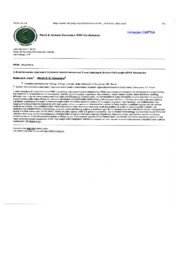A bioinformatics approach to detect interchromosomal trans-splicing in bovine full length cDNA databanks.
A bioinformatics approach to detect interchromosomal trans-splicing in bovine full length cDNA databanks.
Author(s): HERAI, R. H.; YAMAGISHI, M. E. B.
Summary: Trans-splicing is an unusual form of RNA processing mechanism where distinct pre-mRNA sequences contribute to the formation of a single mRNA. It is common in nematodes and kinetoplastids, but it is rare in superior organisms. Nevertheless, some recent studies show that trans-splicing, although rare, may be more widespread than believed (Gingeras). Consequently, its identification in large databanks is very important for posteriori experimental confirmation. Recently, we have developed a Bioinformatic methodology that successfully found 16 inter-chromosomal trans-splicing candidate sequences in a large human full length cDNA (FlcDNA) databank (Herai & Yamagishi, in press). Unfortunately, our methodology was supposed to be applied on organisms with high quality reference genome, otherwise the number of false positive candidate sequences turned the analysis prohibitive. The problem is that many important model organisms have only draft assemblies. In order to overcome this problem, we extended our bioinformatics methodology applying additional filtering criteria and ad hoc algorithms necessary to deal with those cases. Using 83,048 bovine FlcDNA transcripts (NCBI, MGC, BGD) and Bos taurus UMD 3.0 genome assembly, our extended methodology successfully found 12 hybrid mRNAs which may be the first instances of bovine inter-chromosomal trans-splicing sequences, since the single reported bovine trans-splicing evidence was an intra-chromosomal instance (Roux et al.). Furthermore, just like in the human case, the bovine candidate sequence gene loci had many inverted repeat sequences which may support the conjecture that those sequences may be part of a non-spliceosome mediated trans-splicing mechanism (Di Segni et al.).
Publication year: 2010
Types of publication: Abstract in annals or event proceedings
Keywords: Algorithms, Algoritmo, Bioinformatics, Bioinformática, RNA splicing
Observation
Some of Embrapa's publications are published as ePub files. To read them, use or download one of the following free software options to your computer or mobile device. Android: Google Play Books; IOS: iBooks; Windows and Linux: Calibre.
Access other publications
Access the Agricultural Research Database (BDPA) to consult Embrapa's full library collection and records.
Visit Embrapa Bookstore to purchase books and other publications sold by Embrapa.

